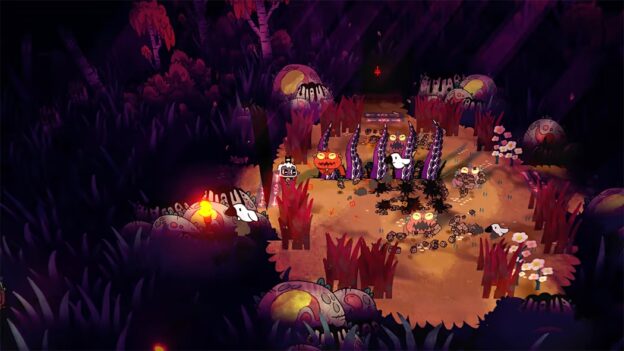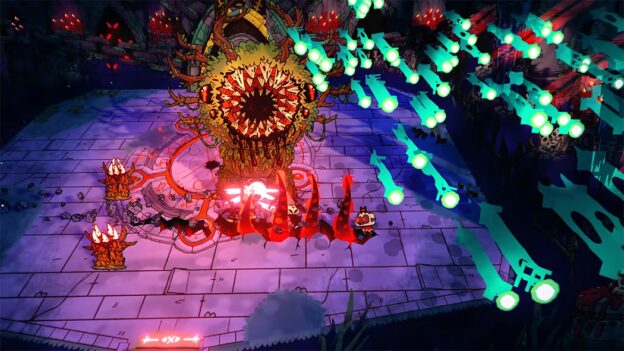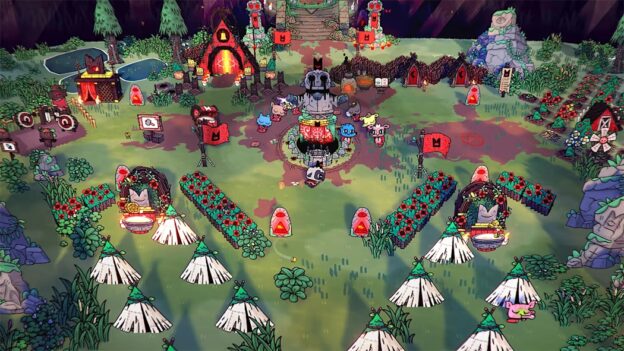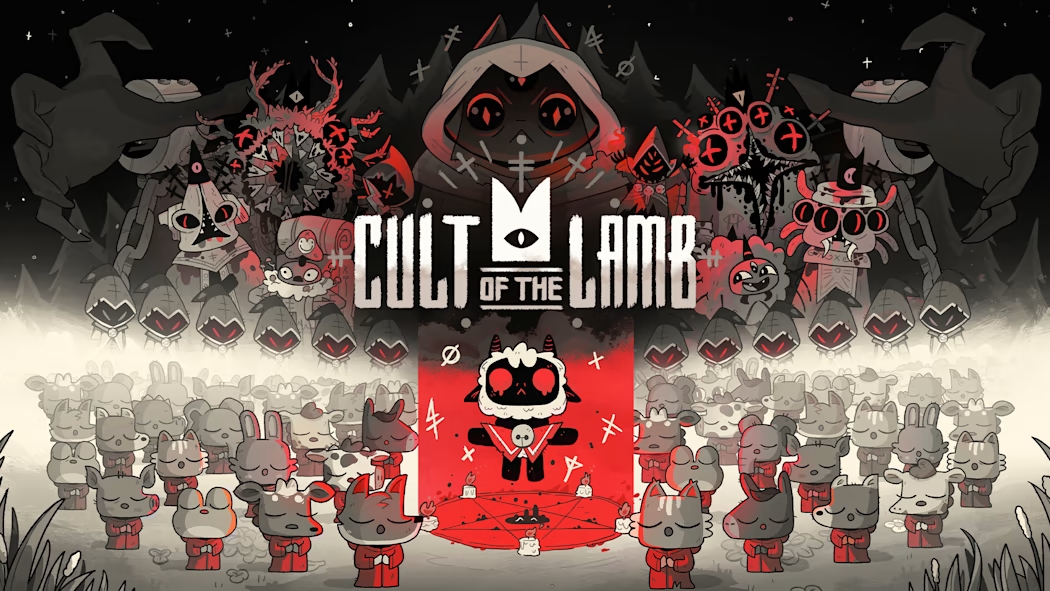How do I put this? Cult of the Lamb is a different game. It involves the creation of an actual cult of followers led by a sacrificial lamb. It couples management elements with roguelike dungeons in a unique combination of genres and ideas. And, somehow, it absolutely works.
You play the role of a lamb put to death by a legion of worshippers. Instead of dying, you’re resurrected by the ominously named The One Who Waits, an ancient god trapped in the afterlife to await his return to Earth. In exchange for granting your second chance at life, you’re requested to start a cult and defeat the four gods keeping The One Who Waits captive.

This plot certainly stands out, but it takes more than a unique story to engage players. Cult of the Lamb excels by evenly dividing itself between two distinct styles of gameplay, balancing action-packed dungeons with the more strategic element of running a cult.
Your first mission is to work your way through one of these dungeons. You’re faced with a series of rooms full of enemies to defeat, with each successful conquest resulting in a chest full of treasure. I’m not typically a fan of roguelikes, but Cult of the Lamb does it well. The simple rooms and combat keep things moving quickly, with enough variance in enemies and obstacles to retain my interest.
You initially wield a melee weapon, like an ax or sword, which differs on each run. I had a great time hacking and slashing my way through rooms; almost everything can be demolished. This makes dungeons a great way to find resources for your camp as well, like grass, stone, and lumber. Your character can also dash, which is particularly useful for avoiding enemy attacks. Although the enemies aren’t overly tough to begin with, they ramp up as you progress, and there are four difficulty levels to give you more or less of a challenge.

In true roguelike fashion, each run is different, with pathways and rooms changing accordingly. You can choose one of several paths on your way through, with specific rewards on offer; do you want more followers, better weapons, or more supplies? Finally, each run ends with a boss fight. These oversized enemies spew fire, poison, or even smaller enemies at you, with loads of rewards offered on defeat.
After successfully navigating your first dungeon, it’s time to create your cult. What seems like a dark and foreboding task is actually a rather cute exercise in management. While the dungeons are fun, this aspect is where Cult of the Lamb truly shines; it’s like a twisted version of Animal Crossing. There are resources to acquire, seeds to sow, buildings to erect, and followers to keep healthy, happy, and faithful.
Your job starts off simply with only a handful of devotees. Once you acquire ten or more, things become complicated. You need more beds. You need more food. You also need, er, facilities to take care of their waste. Oh, and a prison because sometimes your followers are naughty.

Keeping your followers happy is monitored by several meters on your screen, such as hunger and faith. How do you keep them happy? By building beds for them to sleep in (otherwise, it’s the ground tonight), feeding them, giving them a place to pray, and ensuring the place is generally clean. You can also decorate the area with unlockable designs, preach your daily sermon, and complete short quests on your followers’ behalf. The more you’re worshiped, the more devotion points you earn, which unlock even more ways to expand your camp. It’s an absolute blast to collect these and see your facilities grow. I just want my flock to be happy!
Yes, your followers have feelings. They argue among themselves, make friends with each other – don’t interrupt them, though! – and even become annoyed if you wake them up too early. They can get sick, too, so you have to be sure to clean up after them. Oh yes, the animals will simply poop on the ground; until you build a bathroom, that is. It’s so quirky yet rich in terms of the sheer amount to do.
Your followers take the form of adorable animals, from giraffes and zebras, to donkeys, rabbits, and even red pandas. You can rename and reclass them as another animal, or recolor them to be any shade of the rainbow. This cute aesthetic helps lighten the tone of Cult of the Lamb, which certainly has its dark moments. Graphically, your camp is lighter and brighter in color, compared to the dingy dungeons, but certain aspects highlight a darker tone. This includes the fact that your followers will most certainly die at some point, whether by old age, poisoned food, or even via a sacrifice ritual. Yikes!
There’s even more to add longevity to the game. Collectible tarot cards boost your health or strength. Rituals and doctrines provide certainty and faith to your crew. Unlockable areas surrounding the camp offer further exploration, including minigames like knucklebones and fishing. There’s so much going on, and it’s addictively fun to play and uncover it all.
Overall, Cult of the Lamb is a breath of fresh air. In a gaming world full of roguelikes, this offers a different take on the genre, mashing it with a management sim that is oh-so-much fun. The cutesy graphics help tone it down, but don’t be mistaken – this is a dark game at times; it’s also a must-play title if you’re looking for something new and different.
Review: Cult of the Lamb (Nintendo Switch)
Great
Cult of the Lamb is a unique game in a world full of roguelikes, mashed together with a management sim that is oh-so-much fun. The cutesy graphics help tone it down, but don’t be mistaken – this is a dark game at times; it’s also a must-play title if you’re looking for something a little different.


